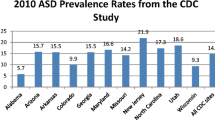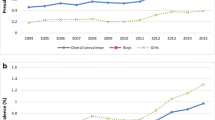Abstract
Since 2000, the Autism and Developmental Disabilities Network (ADDM) has published detailed prevalence estimates for autism spectrum disorder (ASD) among 8 year-olds, which are widely interpreted as the U.S. national prevalence of ASD. Although differences in state-level ASD prevalence has been reported, state-level heterogeneity has not been explored systematically. We analyzed state-level estimates and trends in ASD prevalence from 2000 to 2012 using secondary data from bi-annual ADDM reports. Heterogeneity among state-level ASD prevalence estimates were apparent in 2000 and grew between 2000 and 2012. Findings highlight the need for greater understanding of how children with ASD are identified by the medical and educational systems, which has significant implications for the state-level resources required to effectively manage ASD.



Similar content being viewed by others
References
Blumberg, S. J., Bramlett, M. D., Kogan, M. D., Schieve, L. A., Jones, J. R., & Lu, M. C. (2013). Changes in prevalence of parent-reported autism spectrum disorder in school-aged U. S. children: 2007 to 2011–2012. National Health Statistics Reports, 65, 1–11.
Centers for Disease Control and Prevention. (2007a). Evaluation of a methodology for a collaborative multiple source surveillance network for autism spectrum disorders—Autism and Developmental Disabilities Monitoring Network. MMWR, 56(SS-1), 30–40.
Centers for Disease Control and Prevention. (2007b). Prevalence of autism spectrum disorders—Autism and Developmental Disabilities Monitoring Network, Six Sites, United States, 2000. MMWR, 56(SS-1), 1–10.
Centers for Disease Control and Prevention. (2009a). Brief update: prevalence of autism spectrum disorders (ASDs): Autism and Developmental Disabilities Monitoring (ADDM) Network, United States, 2004. MMWR, 58(SS-10), 21–24.
Centers for Disease Control and Prevention. (2009b). Prevalence of autism spectrum disorders—Autism and Developmental Disabilities Monitoring Network, United States 2006. MMWR, 58(SS-10), 1–24.
Centers for Disease Control and Prevention. (2012). Prevalence of autism spectrum disorders—Autism and Developmental Disabilities Monitoring Network, 14 Sites, United States, 2008. MMWR, 61(SS-3), 2–18.
Centers for Disease Control and Prevention. (2014). Prevalence of autism spectrum disorder among children aged 8 years—Autism and Developmental Disabilities Monitoring Network, 11 sites, United States, 2010. MMWR, 63(SS-2), 1–21.
Christensen, D. L., Baio, J., Braun, K. V. N., Bilder, D., Charles, J., Constantino, J. N., … Yeargin-Allsopp, M. (2016). Prevalence and characteristics of autism spectrum disorder among children aged 8 years—Autism and Developmental Disabilities Monitoring Network, 11 Sites, United States, 2012. MMWR Surveillance Summaries, 65(3), 1–23. https://doi.org/10.15585/mmwr.ss6503a1.
Hansen, S. N., Schendel, D. E., Parner, E. T. (2015). Explaining the increase in the prevalence of autism spectrum disorders. JAMA Pediatrics, 169(1), 56. https://doi.org/10.1001/jamapediatrics.2014.1893.
Idring, S., Lundberg, M., Sturm, H., Dalman, C., Gumpert, C., Rai, D., … Magnusson, C. (2015). Changes in prevalence of autism spectrum disorders in 2001–2011: Findings from the Stockholm youth cohort. Journal of Autism and Developmental Disorders, 45(6), 1766–1773. https://doi.org/10.1007/s10803-014-2336-y.
Rice, C. E., Rosanoff, M., Dawson, G., Durkin, M. S., Croen, L. A., Singer, A., & Yeargin-Allsopp, M. (2012). Evaluating changes in the prevalence of the autism spectrum disorders (ASDs). Public Health Reviews, 34(2), 1–22.
Schieve, L. A., Tian, L. H., Baio, J., Rankin, K., Rosenberg, D., Wiggins, L., … Devine, O. (2014). Population attributable fractions for three perinatal risk factors for autism spectrum disorders, 2002 and 2008 autism and developmental disabilities monitoring network. Annals of Epidemiology, 24(4), 260–266. https://doi.org/10.1016/j.annepidem.2013.12.014.
Sheldrick, R. C., Maye, M., & Carter, A. C. (2018). Autism prevalence and cumulative incidence across U.S. surveys. Unpublished manuscript.
Sheldrick, R. C., Maye, M. P., & Carter, A. S. (2017). Age at first identification of autism spectrum disorder: An analysis of two US surveys. Journal of the American Academy of Child & Adolescent Psychiatry, 56(4), 313–320. https://doi.org/10.1016/j.jaac.2017.01.012.
Van Naarden Braun, K., Christensen, D., Doernberg, N., Schieve, L., Rice, C., Wiggins, L., … Yeargin-Allsopp, M. (2015). Trends in the prevalence of autism spectrum disorder, cerebral palsy, hearing loss, intellectual disability, and vision impairment, metropolitan Atlanta, 1991–2010. PLoS ONE, 10(4), e0124120–e0124120. https://doi.org/10.1371/journal.pone.0124120.
Wise, M. D., Little, A. A., Holliman, J. B., Wise, P. H., & Wang, C. J. (2010). Can state early intervention programs meet the increased demand of children suspected of having autism spectrum disorders? Journal of Developmental and Behavioral Pediatrics, 31(6), 469–476. https://doi.org/10.1097/DBP.0b013e3181e56db2.
Acknowledgments
This research was supported in part by a NIMH Grant to the University of Massachusetts Boston and Boston University (R01MH104400). Additionally, the authors would like to acknowledge Victoria E. Sanchez for her contribution in preparing this manuscript for publication.
Author information
Authors and Affiliations
Contributions
RCS conducted all statistical analyses and drafted the paper. ASC edited the draft and refined the conceptualization. Together, RCS and ASC contributed to completing the final manuscript.
Corresponding author
Ethics declarations
Conflict of interest
The authors have no conflict of interest to declare.
Research Involving Human and Animal Rights
This article does not contain any studies with human participants or animals performed by any of the authors.
Electronic supplementary material
Below is the link to the electronic supplementary material.
Rights and permissions
About this article
Cite this article
Sheldrick, R.C., Carter, A.S. State-Level Trends in the Prevalence of Autism Spectrum Disorder (ASD) from 2000 to 2012: A Reanalysis of Findings from the Autism and Developmental Disabilities Network. J Autism Dev Disord 48, 3086–3092 (2018). https://doi.org/10.1007/s10803-018-3568-z
Published:
Issue Date:
DOI: https://doi.org/10.1007/s10803-018-3568-z




